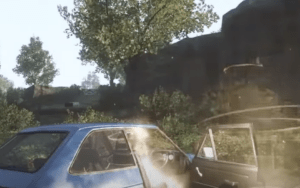Game name: Everybody’s Gone to the Rapture
Developer: The Chinese Room Studio
Audience: The game is targeted towards players age 13+.


Through an intricate interaction between narrative and aesthetics with mechanics similar to that of “walking simulators,” the game weaves a compelling mystery that allows one to piece the picture together through the lens of multiple characters in the game.
The main mechanic of the game is walking. Players follow the guidance of a mystical ball of light that helps them explore a deserted village called Yaughton post-apocalypse. In addition, the slowed walking pace combined with the aesthetic created by the absence of other visible characters creates an atmosphere of isolation and curiosity.
The primary game mechanic in “Everybody’s Gone to the Rapture” is its walking-based exploration. The designers make the choice to forego action or puzzle-solving and focus on a more reflective experience; Unlike traditional games, it foregoes the typical action or puzzle-solving for a more contemplative experience. This mechanic is central to the mystery of the game, as it sets the mood for the rest of the design choices made. The absence of other visible characters and the slow, deliberate pace foster an atmosphere of isolation and intrigue. Players must piece together the story from environmental clues, overheard conversations, and fragments of events that they can witness as ghostly echoes of the past. This method of narrative delivery is subtle and indirect, compelling players to actively interpret and connect the scattered pieces of the story.
Other game mechanics also include the ability to manipulate light to interact with the echoes of past events. Players can converge beams of light that trigger these scenes. This mechanic not only deepens the mystery but also physically involves the player in the unfolding of the story since one would have to tilt their controller a certain way to make this happen, making the discovery process pretty personal.
Game aesthetics like the architecture of Yaughton are also acritical element in controlling the narrative flow. The layout of the village, the wooded paths, homes, and public buildings, are all meticulously crafted to intrigue the player into deviating from following the light, but also help them piece the story together at the same time. Each area is designed to represent a different piece of the narrative puzzle, with specific locations tied to particular characters and events, while other locations offer unexpected finds.
The game incorporates a combination of narrative arcs and loops. Each character’s story represents a separate arc, complete with a beginning, development, and end. These arcs are woven with each other, contributing to the larger narrative of what has happened in Yaughton. At the same time, the game also includes loops. Players can revisit the same locations multiple times (although pretty annoying due to the walking pace), and each visit might reveal new information depending on the narrative. This looping mechanism not only enriches the depth of the narrative but also enhances the mystery since players must piece together information from different times and perspectives to fully understand the events of the game.



